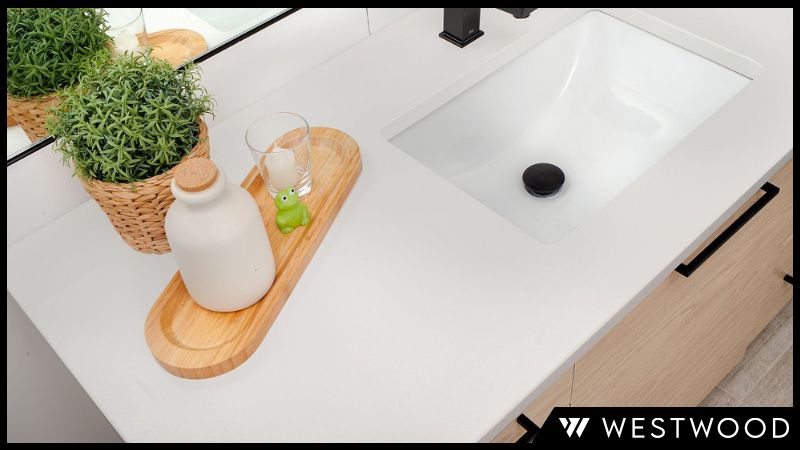
Pairing bathroom cabinets with countertops requires a keen understanding of aesthetics and functionality. A harmonious bathroom design often hinges on successful color coordination, where cabinets and countertops can complement or contrast beautifully. Texture also plays a role, introducing depth and tactile experience to the space. Beyond the visual appeal, the practicality of the choices is crucial, factoring in daily usage and durability. It's essential to ensure a consistent design language, where the selected cabinet and countertop resonate with the bathroom's overall theme. By weaving together these elements of color, texture, functionality, and design, homeowners can create a cohesive bathroom space that not only looks inviting but also meets its practical needs.
In the realm of interior design, there's a certain magic that happens when various elements come together in perfect harmony. This couldn't be truer when it comes to pairing bathroom cabinets with countertops. Achieving balance and harmony while ensuring functionality can sometimes seem challenging, but with the right knowledge and a touch of creativity, it is entirely within reach. In this guide, we'll explore the art of creating a cohesive bathroom space by skillfully pairing cabinets with countertops.
At the heart of any well-coordinated space lies the principle of color harmony. In the bathroom, cabinets and countertops can either complement or contrast with each other. For instance, a dark wooden cabinet could be beautifully juxtaposed against a light-colored marble countertop, creating a striking balance. On the flip side, using similar shades, like pale woods with light-colored quartz, can evoke a serene, spa-like ambiance. The key is to envision the mood you desire and then experiment with swatches to discover combinations that resonate with that vision. Keep in mind the room's lighting as well. Natural light can bring out subtle undertones in materials, which can influence your color choices.
Texture introduces another layer of depth to your bathroom's design narrative. Smooth, polished countertops paired with intricately grained wooden cabinets can result in a delightful play of textures. This interplay can make the space visually intriguing and tactilely pleasing. For those who prefer a sleek, modern look, matching the textures, say with gloss-finished cabinets and a high-gloss granite countertop, can provide that streamlined aesthetic. Alternatively, embracing a rustic vibe with a matte-finished countertop and reclaimed wood cabinetry can transport one to a countryside retreat. Remember, texture doesn't just appeal visually – it engages the sense of touch, enhancing the overall user experience in the bathroom.
While aesthetics are paramount, functionality shouldn't take a backseat. The chosen countertop should not only gel with the cabinet in terms of appearance but also in terms of practicality. Think about the usage and the occupants of the home. A family bathroom might benefit from a durable quartz countertop, which can withstand the rigors of daily use, coupled with sturdy, easy-to-clean cabinets. For those who don't anticipate heavy usage and prioritize luxury, options like a marble countertop paired with custom-designed cabinetry could be explored. Always gauge your choices based on your lifestyle, ensuring that beauty doesn't overshadow utility.
Every design tells a story, and ensuring that your bathroom speaks a consistent design language is vital. If you're leaning towards a contemporary theme, pairing minimalist cabinet designs with sleek countertops that have clean lines will reinforce this narrative. Conversely, if a vintage charm is what you're after, ornate cabinet designs combined with classic countertop materials like soapstone or tiled mosaics would be more apt. A haphazard mix of styles can lead to a disjointed feel. So, as you select your cabinet and countertop pair, ensure they echo the same design sentiments and contribute cohesively to the overarching theme.
In conclusion, pairing bathroom cabinets with countertops is an art that balances aesthetics and functionality. By attuning ourselves to the principles of color coordination, texture interplay, practicality, and consistent design language, we can curate a bathroom space that is not only visually appealing but also truly harmonious. As with any design journey, it's essential to let your individual tastes and preferences shine through. After all, the most enchanting spaces are those that reflect the personality and passions of their inhabitants. So, embark on this journey of pairing with an open heart, allowing your unique flair to infuse the space with harmony and charm.
Written on behalf of Westwood Fine Cabinetry.
Texture adds depth and dimension to a bathroom, making it visually intriguing. It also affects the tactile experience, influencing how the surfaces feel to the touch.
Evaluate your daily usage and choose materials and designs that can withstand the wear while meeting storage and aesthetic needs.
While wood brings warmth, it requires sealing and regular maintenance to prevent water damage in a bathroom setting.
Whether you're transforming a living space or embarking on a new build, Westwood offers stylish and functional designs that elevate every room in your home. With a focus on exceptional quality, tailored solutions, and unmatched customer service, we bring industry insight and expertise to every project. Choose Westwood for outstanding cabinetry solutions that exceed your expectations. Connect with us today and experience the Westwood difference.